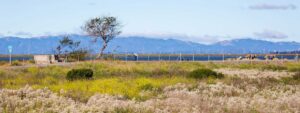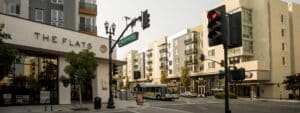Michael Moore
An organized development schedule in Morgan Hill’s southeast quadrant is one step closer to fruition, but the current objections of a county agency whose approval is crucial to the city’s plans present a possible hurdle.
With the city council’s unanimous approval Wednesday of a project description for the 1,200-acre, mostly agricultural area, construction on a series of sports-related projects and a Catholic school is still a long way off.
Now that the project description is in place, the city can proceed on an environmental study of the plans, another state-mandated process before ultimate approval of the city’s expansion. City staff hope the environmental study can be completed by the end of this year, according to senior planner Rebecca Tolentino.
The project description, which serves as a preliminary blueprint for zoning classifications and specific development projects, assumes that long-term agricultural use of the land is economically feasible on a small scale.
None of the land is currently inside the city limits, and implementation of the project will require the city to expand its urban limit line, which was last updated in 2005 as the boundary beyond which the city will not develop. That expansion will require the approval of the Santa Clara County Local Agency Formation Commission.
A strongly-worded letter from the LAFCO executive officer, sent to the city Tuesday, says the current project description violates the commission’s policies, and particularly its intent to preserve agricultural land.
The letter from Neelima Palacherla says the city should develop properties already in the city limits rather than expanding into areas that could strain public services.
“The city’s … proposals for the SEQ area in their present form are contrary to LAFCO objectives of preventing urban sprawl and preventing premature conversion of agricultural lands,” said the letter.
Some councilmembers said the letter was unusually harsh, considering it is based only on preliminary plans.
“I have some concerns about the executive officer taking a position on the part of their board, rather than getting a decision from LAFCO itself,” Mayor Steve Tate said. “(LAFCO staff) is trying to enforce their interpretation of agricultural mitigation policies on our community.”
At some point after the environmental study is complete, the city will submit an application to LAFCO. Until then, the commission will not make any decisions on the project, and will only discuss the southeast quadrant to inform its board members, Palacherla explained.
She said the purpose of the letter was to give the city ample notice that its plans appear to contradict LAFCO’s purpose, so they will have time to make fixes before it comes up for a vote.
Supervisor Don Gage, a LAFCO commissioner, said he has not seen the letter and is not familiar with the southeast quadrant plans. The project will be discussed for informational purposes at the April 21 LAFCO meeting.
A map of the southeast quadrant’s project description, presented at Wednesday’s meeting, indicates at least 280 acres of the region will remain agricultural, and at least 190 acres would be zoned sports-recreation-leisure. That label would apply to the city’s Outdoor Sports Complex on Condit Road.
The southeast quadrant is east of U.S. 101, between San Pedro Avenue and Maple Avenue.
Slightly more than half the SEQ — about 695 acres — is used for agriculture, and is considered “prime farmland,” according to consultant Gregory House, who studied the quad’s agricultural viability on behalf of the city.
Non-agricultural plans already on tap for the southeast quadrant include a Catholic high school campus, an artificial snowboarding and ski mountain proposed by Snowflex, and more sports fields including privately owned cricket and polo fields proposed by Chiala Farms owner George Chiala.
Already established in the southeast quadrant are the OSC and Aquatics Center, both owned by the city. Another property owner has proposed a 43,000-square-foot “sports retail” complex south of the Aquatics Center near Condit Road and Tennant Avenue.
Chiala has also proposed a mixed-use residential and open space development on 305 acres he owns in the southeast quadrant — land that is currently used for farm production.
The project description also supports the city devising agricultural mitigation rules to ensure that when any developer transforms agricultural property into more urban landscapes, they will help the city permanently preserve an equal portion of open space or farmland elsewhere in town.
Such a policy would apply not only to the southeast quadrant, but to properties throughout the entire city. The city’s general plan has long stated a need to study the options for such a policy, and that study is underway.
A consultant hired by the city to conduct the study suggested a multi-pronged policy to ensure mitigation. That option includes assessing fees of up to $20,000 per acre to purchase other lands to preserve, and working with an organization such as a land trust to obtain permanent conservation easements and open space property donations, according to Teifion Rice-Evans of Economic & Planning Systems. The city could also rededicate future local funds to agricultural preservation, pursue grant funding, and even consider a special sales tax for the purpose in the future.
While the city could choose to mitigate urban development with the preservation of farmland in other communities in Santa Clara County, Councilman Larry Carr said he wants to keep it local.
“I’m not interested in a program that preserves agricultural land elsewhere in the county. What we’ve been talking about is preserving agricultural land in the southeast quadrant,” Carr said.
Details of a mitigation policy that satisfies LAFCO will be determined by the council as the environmental study proceeds. That study will cost about $482,000. The city allocated about $173,000 to pay for its share of the EIR in the current year’s budget. The remainder of the cost will be shared by five private developers with project plans in the works.
The council heard public comments from about a dozen people Wednesday, most of whom were property owners or developers who support the city’s plans.
John Telfer, a Morgan Hill developer, said the only other option to the current SEQ plan is the status quo, which will allow the rural properties to become residential developments.
“Some of (the SEQ parcels) can be further subdivided,” Telfer said. “If it’s left alone, economics will dictate a lot of these properties will be converted into mini-ranchettes.”
Opposed to the project is the Greenbelt Alliance, a San Francisco-based open space advocacy group which sent a letter Wednesday. The letter echoes the concerns of LAFCO, and asks the city to tweak its proposal to ensure the bulk of the SEQ property is left alone.
“This land is not needed for development and it is questionable whether Morgan Hill can afford to provide services to a more spread out community. The city is putting attention and money outside its (urban limit line), when it is the libraries, roads, parks and police within city limits that need the council’s attention,” the letter signed by the alliance’s senior field representative Michele Beasley stated.
This article was originally published in the Morgan Hill Times.




